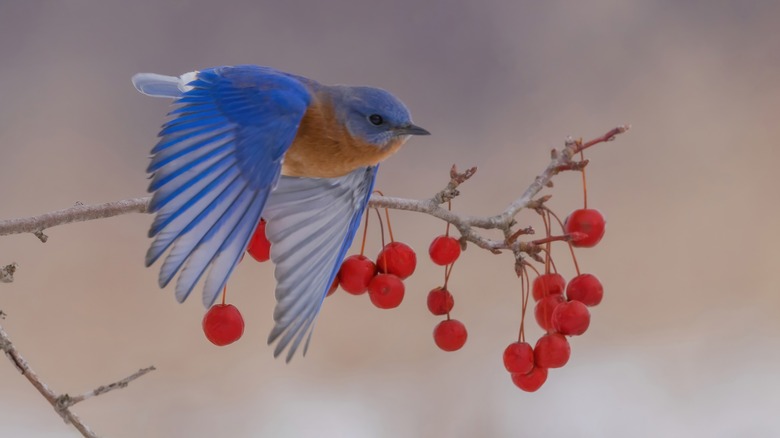Does The Color Blue Actually Attract Bluebirds To Your Yard? Here's What We Know
What's more joyful than seeing the cyan hues of a bluebird in your blossoming garden? Bluebirds, scientific name Sialia sialis, are native to North America. And though they've become more common in recent years thanks to a steadily increasing population, you may still be wondering what you can do to get these stunning creatures in your yard. Some say the best way to make your garden appealing to bluebirds is to add plenty of blue to the mix, whether it's indigo flowers or cobalt bird feeders. Curious if this old wisdom holds true, we spoke to an expert. In an exclusive interview with House Digest, Zach Hutchinson, an ornithologist and head flocker at Flocking Around, gave us the scoop.
"All birds have color preferences, and several studies have indicated that 'energetic colors,' certain UV wavelengths, and polarized lights can attract more birds than neutral colors," Hutchinson explained. Still, he doesn't believe blue is the key to attracting this species. "Does the color blue attract bluebirds?" he said. "Possibly, it draws their initial attention, but over the long term, the color blue is not essential to luring and keeping bluebirds in your yard or garden." Essentially, it's probably not the best way to bring all the bluebirds to the yard. "Color is not where energy needs to be focused to attract bluebirds," Hutchinson said.
Happy habitats are more important than blue for bluebirds
Since there's a possibility that blue might attract bluebirds, you may be wondering if there are any blue flowers you should be certain to plant in the garden. Zach Hutchinson said this isn't the best strategy. "Planting blue flowers is not an essential step," he told House Digest in our exclusive talk. That's because they don't eat nectar. These birds need a solid food source to entice them to stop by, and providing one is one of the best ways to get them to visit over the short and long term. "Planting blue flowers is unlikely to attract bluebirds any quicker than quality habitat, nesting space, and food availability," Hutchinson said.
Hutchinson gave us some tips that will go a long way to providing an inviting area for bluebirds. Instead of focusing on colors, he said to focus on nestboxes, habitat, and multi-season food availability. "[These] are far more crucial to those creating a haven for bluebirds," he said. But that doesn't mean you should ignore color choices altogether. "If using a feeder filled with mealworms to attract bluebirds, use brightly colored feeders such as blue, red, and green," Hutchinson added. You can also try building a bluebird house with our tips and tricks to create a welcoming environment for these feathered friends.
What to plant instead
So what's a good plant to add to the garden if you don't need to add a bunch of blue flowers? "Plant native shrubs that produce red berries as a provision for the fall and winter diets of bluebirds," Zach Hutchinson advised in his exclusive interview with House Digest. He recommended mistletoe and sumac for people living in the eastern bluebird range, as these provide hearty calories. But there's a caveat. "Possibly even more important than berries are the plants that host native insects," Hutchinson added. "During the breeding season, insects are vital to nesting bluebirds. Put plants in your garden that host butterfly and moth caterpillars, as well as grasshoppers and crickets. Food options are the true way to be a helpful host for bluebirds."
To keep insects aplenty in the garden, avoid non-native flowers and plants. "These are less optimal for hosting native insects and berries," Hutchinson explained. "While some ornamental non-native plants might be okay in a garden, too many non-natives can create an insect desert. Without ample native bugs, bluebirds have less to feed baby bluebirds." So you're not just trying to capture the initial attention of bluebirds, which a colorful garden may or may not do — you also need to give them a comfortable habitat to nest and feed not only themselves, but the next generation of bluebirds.


